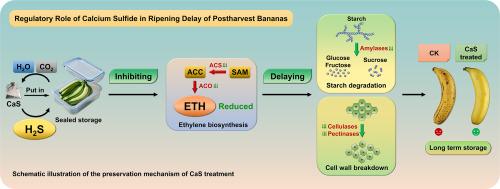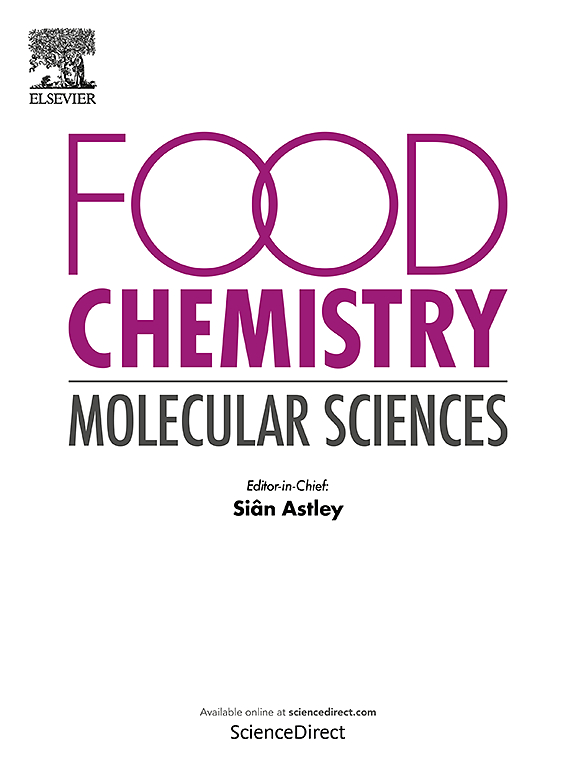Regulatory role of calcium sulfide in ripening delay of postharvest bananas
IF 4.7
Q2 FOOD SCIENCE & TECHNOLOGY
引用次数: 0
Abstract
Hydrogen sulfide (H₂S) has been demonstrated to delay ripening and senescence in various fruits, offering great capability for postharvest preservation. However, existing application methods face several limitations, such as unstable release, difficulty in dosage control, and safety concerns, and its regulatory mechanisms in fruit systems remain unclear. In this study, calcium sulfide (CaS) was used as a slow-release H₂S donor that gradually releases H₂S through reactions with airborne moisture and carbon dioxide to treat bananas. CaS treatment significantly downregulated key ethylene biosynthetic genes and corresponding enzymes (ACO and ACS), thereby reducing ethylene production. The expression of starch-degrading and cell wall-modifying genes was also suppressed, delaying starch breakdown and cell wall disassembly. Enzyme assays and transcriptomic analyses confirmed that CaS delays banana ripening through coordinated regulation at both transcriptional and biochemical levels. As a result, CaS treatment effectively extended shelf life and maintained fruit quality of bananas. These findings reveal the potential of CaS as a novel H₂S-releasing agent for postharvest preservation.

硫化钙对香蕉采后延迟成熟的调控作用
硫化氢(H₂S)已被证明可以延缓各种水果的成熟和衰老,为采后保存提供了很大的能力。然而,现有的应用方法存在释放不稳定、剂量控制困难、安全性问题等局限性,且其在水果系统中的调控机制尚不清楚。在本研究中,硫化钙(CaS)作为缓释H₂S供体,通过与空气中的水分和二氧化碳反应逐渐释放H₂S来处理香蕉。CaS处理显著下调了关键的乙烯生物合成基因(ACO)和相应的酶(ACS),从而降低了乙烯的产量。淀粉降解和细胞壁修饰基因的表达也受到抑制,延缓了淀粉的分解和细胞壁的破坏。酶分析和转录组学分析证实,CaS通过转录和生化水平的协调调节延迟香蕉成熟。结果表明,CaS处理有效地延长了香蕉的货架期,保持了香蕉的果实品质。这些发现揭示了CaS作为一种新的H₂释放剂用于采后保存的潜力。
本文章由计算机程序翻译,如有差异,请以英文原文为准。
求助全文
约1分钟内获得全文
求助全文
来源期刊

Food Chemistry Molecular Sciences
Agricultural and Biological Sciences-Food Science
CiteScore
6.00
自引率
0.00%
发文量
83
审稿时长
82 days
期刊介绍:
Food Chemistry: Molecular Sciences is one of three companion journals to the highly respected Food Chemistry.
Food Chemistry: Molecular Sciences is an open access journal publishing research advancing the theory and practice of molecular sciences of foods.
The types of articles considered are original research articles, analytical methods, comprehensive reviews and commentaries.
Topics include:
Molecular sciences relating to major and minor components of food (nutrients and bioactives) and their physiological, sensory, flavour, and microbiological aspects; data must be sufficient to demonstrate relevance to foods and as consumed by humans
Changes in molecular composition or structure in foods occurring or induced during growth, distribution and processing (industrial or domestic) or as a result of human metabolism
Quality, safety, authenticity and traceability of foods and packaging materials
Valorisation of food waste arising from processing and exploitation of by-products
Molecular sciences of additives, contaminants including agro-chemicals, together with their metabolism, food fate and benefit: risk to human health
Novel analytical and computational (bioinformatics) methods related to foods as consumed, nutrients and bioactives, sensory, metabolic fate, and origins of foods. Articles must be concerned with new or novel methods or novel uses and must be applied to real-world samples to demonstrate robustness. Those dealing with significant improvements to existing methods or foods and commodities from different regions, and re-use of existing data will be considered, provided authors can establish sufficient originality.
 求助内容:
求助内容: 应助结果提醒方式:
应助结果提醒方式:


